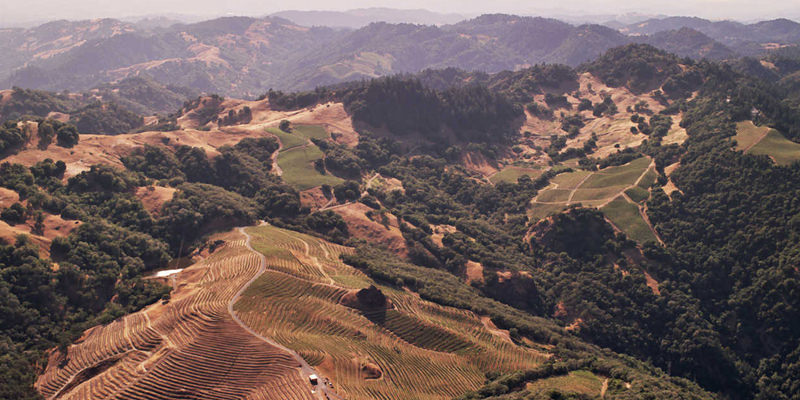Running a vineyard is like selling real estate: location is everything.
That’s not news if you’re an adventurous wine drinker and have discovered that wines from snowy hilltops in Germany taste different from those from sunny California. But “location” isn’t always simple. In the best and worst climates, from the frozen Finger Lakes to Grecian islands, it’s how a vineyard site is situated that makes all the difference.
In the wine biz, the way a vineyard is placed — facing the sun or away from it — is called “aspect,” and it’s a critical element of terroir and grape growing. Terroir is the personality a wine gets from its combination of climate, soils, and winemaking technique, and aspect is centrally embedded in climate. Specifically, aspect refers to the direction — north versus south, east versus west — that a vineyard faces. It can also refer to the slope and elevation of the terrain, two additional factors that influence how hot and thus how ripe grapes get in a given place. The intensity of a region’s climate makes aspect more or less important but wherever grapes are cultivated, aspect plays an important role.
In essence, the particular aspect of a vineyard determines when and how often vines are on the proverbial sunny side of the street. Too much sun and grapes trade their complex flavor molecules for pure sugar, eliminating the acidity that keeps all wine refreshing. But too little sun and wines taste bitter, green, and painfully tart.
In the Northern Hemisphere, southern- and western-facing areas are warmer, and warm earlier in the springtime. This not only ensures ripening in cool vintages, but also prevents against frost damage in early spring.
Especially in cool climates, like Germany, northern Italy, and the Finger Lakes, southerly aspect allows grapes to ripen where they otherwise could not. In these chilly locales, it takes every drop of sunshine just to ripen grapes. As a result, almost all vineyards face directly south to absorb the most sunlight and heat from dawn until dusk. Across parts of Germany and Piedmont, vineyards and bottlings are named for their coveted southern aspect.
Even in regions where grapes ripen easily, aspect still has a dramatic effect. “We tend to think grape variety drives flavor, but it’s location,” says winemaker Chris Howell of Cain Vineyard and Winery in Napa. “Location transcends grape variety every time.”
In the Spring Mountain District of Napa, where Cain’s vineyards are perched on the Mayacamas Mountains, grapes ripen easily. But bowl-shaped slopes and sun exposure vary wildly, making each vineyard block unique.
“I always thought I’d like the north-facing, cooler slopes better in Napa,” says Cain, “But now I appreciate both sides. North and south never have the same flavor, and that’s important in cold years like 2011.”
North-facing and eastern slopes are cooler than southern slopes, because they face less direct sunlight. In many regions, easterly facings are preferred because they receive gentle morning sun, as opposed to the intense afternoon heat that batters west-facing vineyards. In these vineyards, like many in Burgundy, the morning sun quickly dries dew and rain, preventing rot and mold. Southwestern slopes, on the other hand, have cool mornings and face the harsh afternoon sun, which can stress vines in warm climates and sunburn fruit.
“Across the great vineyards of the world, not just at Cain, we can see how that morning sun makes a huge difference,” explains Howell. “Barolo is one huge, bowl-shaped hill, and like in Napa, you can taste the difference from one side to the other.”
Aspect and terrain interact in vineyards of all shapes and facings and create microclimates adored (and occasionally dreaded) by vintners worldwide. For example, rolling hills create areas that face sharply east for morning sun, or offer crucial wind protection in cold river valleys. Sharp hillsides, where cold air rushes toward the ground and away from vines, add an extra element of warmth in cooler regions.
“Aspect absolutely creates microclimates,” says Howell. “The spots we harvest first are the most protected from cold winds. Every site and vineyard is different and extremely specific based on the local climate. Depending on location, we might ask, ‘How much wind protection do we want? How much sun do we want?’”
At Cain, where vineyards face every imaginable direction, Howell’s team reacts accordingly. “We always say we can’t pick it all in a day, or even in a week,” he explains. “We picked based on aspect and variety, which is why all of our wines bear a familial resemblance to each other, but are each distinct.”
While Cain’s aspect enhances its wines, cold regions live and die by their aspects, with sunlight equating directly to success. In hot regions, vintners even arrange their rows of grapevines to take advantage of or deflect the sun, and trim the leaves for the same purpose.
When it comes to great wine, it’s not just where the vineyard is planted, but how.

